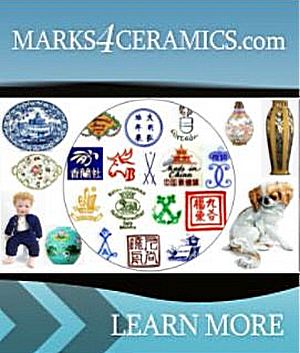CHINA or DINNERWARE PATTERNS:
Patterns & Designs on Chinaware, Teapots, Coffee Sets, Cups & Saucers
China patterns are intricate designs that adorn a variety of tableware, including dinnerware, tea sets, chocolate sets, and other chinaware. Porcelain china often comes in a series, with some designs being issued individually by manufacturers. While many china patterns are repeated or re-issued over time, with some variations in elements such as color or border shape, some designs are registered and protected, but only for a limited time. As a result, many patterns are often duplicated or copied by other makers.
In the mid-to-late 19th century, most china patterns were officially registered and issued a patent or design number, especially in England. However, this practice is not commonly seen today. Early patterns were typically simple and utilized one or two colors, with many imitating Chinese or Oriental scenes, also known as Chinoiserie. The Blue Willow pattern and other Blue & White patterns, such as Flow Blue, are some of the most famous examples of these designs. It is important to note that not all chinaware was made of porcelain or bone china, with stoneware, earthenware, and later ironstone also being popular choices in Europe and America.
China patterns should not be confused with style. While some patterns clearly imitated a certain "look," such as Imari from Japan or Delft from Holland, most chinaware patterns have a unique design that adds to their decorative appeal. For example, the Imari style is available in many different versions, with distinct variations between those made by different manufacturers such as Royal Crown Derby, Coalport, Noritake, Mason's Ironstone, and others. Although most of these companies called their version "Imari," the term correctly refers to a style found on many other porcelain items, including vases and figurines, originating from a particular location in Japan where white porcelain decorated with rich blue and gold colors was developed many centuries ago.
Various techniques were used to apply patterns on tableware and other dinnerware sets, with transferware being the most commonly used method. Artists designed a transferware master sheet or decal, which was then recreated in large numbers of thin film-like sheets that were applied to each dish, plate, cup and saucer, or teapot. For more expensive chinaware, artists would apply hand-painted accents or decorative elements to enhance the overall design. Today's transferware methods allow for multiple layers in different colors, creating more vibrant patterns without the need for manual decorative enhancements.
Most porcelain chinaware feature decorative arrangements that represent floral or animal themes, historical places or persons, popular tourist destinations, stories and fables, or abstract and geometric drawings in colorful combinations. Most patterns are named by the theme they represent, which, along with the manufacturer, identifies them and usually dates them. The spelling of certain patterns has changed over the years, or was deliberately varied by certain manufacturers to distinguish them from the competition.
It is crucial to differentiate between dinnerware patterns and decorative designs applied on plates meant for display, such as those made in Vienna, Austria, and Limoges, France, or those created for the tourist industry depicting places, bridges, castles, harbors, rivers, and mountains. These decorative plates were typically decorated by hand and by experienced artists, some of whom also worked in other media, such as oil-on-canvas or watercolor paintings. Although some of these display plates were produced as a series, they are not regarded as patterns in the same sense as when applied to chinaware. After the 1930s, industrial methods to reproduce designs in full color were vastly improved, resulting in most decorative plates made from the mid-20th century onwards not necessarily being painted by hand, regardless of whether there is a signature on the plate or not.
More detailed information on researching the maker or age for porcelain, chinaware, and pottery is available to members of our marks4ceramics section of our marks4antiques.com website
Unlock the true value
of your collection with our comprehensive research guides from identifying makers' marks to appraising all kinds of
antiques and collectibles.
Our up-to-date information will give you an accurate understanding of your items' worth. Don't miss out on this
valuable resource - visit our research tools today!
Search our price guide for your
own treasures





